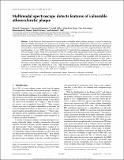Multimodal spectroscopy detects features of vulnerable atherosclerotic plaque
Author(s)
Scepanovic, Obrad R.; Kong, Chae-Ryon; Volynskaya, Zoya I.; Dasari, Ramachandra Rao; Kramer, John R.; Feld, Michael S.; Fitzmaurice, Maryann; Miller, Arnold; ... Show more Show less
DownloadScepanovic-2011-Multimodal spectroscopy detects features of vulnerable atherosclerotic.pdf (491.2Kb)
PUBLISHER_POLICY
Publisher Policy
Article is made available in accordance with the publisher's policy and may be subject to US copyright law. Please refer to the publisher's site for terms of use.
Terms of use
Metadata
Show full item recordAbstract
Early detection and treatment of rupture-prone vulnerable atherosclerotic plaques is critical to reducing patient mortality associated with cardiovascular disease. The combination of reflectance, fluorescence, and Raman spectroscopy—termed multimodal spectroscopy (MMS)—provides detailed biochemical information about tissue and can detect vulnerable plaque features: thin fibrous cap (TFC), necrotic core (NC), superficial foam cells (SFC), and thrombus. Ex vivo MMS spectra are collected from 12 patients that underwent carotid endarterectomy or femoral bypass surgery. Data are collected by means of a unitary MMS optical fiber probe and a portable clinical instrument. Blinded histopathological analysis is used to assess the vulnerability of each spectrally evaluated artery lesion. Modeling of the ex vivo MMS spectra produce objective parameters that correlate with the presence of vulnerable plaque features: TFC with fluorescence parameters indicative of collagen presence; NC/SFC with a combination of diffuse reflectance β-carotene/ceroid [beta-carotene / ceroid] absorption and the Raman spectral signature of lipids; and thrombus with its Raman signature. Using these parameters, suspected vulnerable plaques can be detected with a sensitivity of 96% and specificity of 72%. These encouraging results warrant the continued development of MMS as a catheter-based clinical diagnostic technique for early detection of vulnerable plaques.
Date issued
2011-01Department
Massachusetts Institute of Technology. Laser Biomedical Research Center; Massachusetts Institute of Technology. Spectroscopy LaboratoryJournal
Journal of Biomedical Optics
Publisher
SPIE - Society of Photo-optical Instrumentation Engineers.
Citation
Šćepanović, Obrad R. et al. “Multimodal Spectroscopy Detects Features of Vulnerable Atherosclerotic Plaque.” Journal of Biomedical Optics 16.1 (2011) : 011009. © 2011 Society of Photo-Optical Instrumentation Engineers (SPIE)
Version: Final published version
ISSN
1083-3668